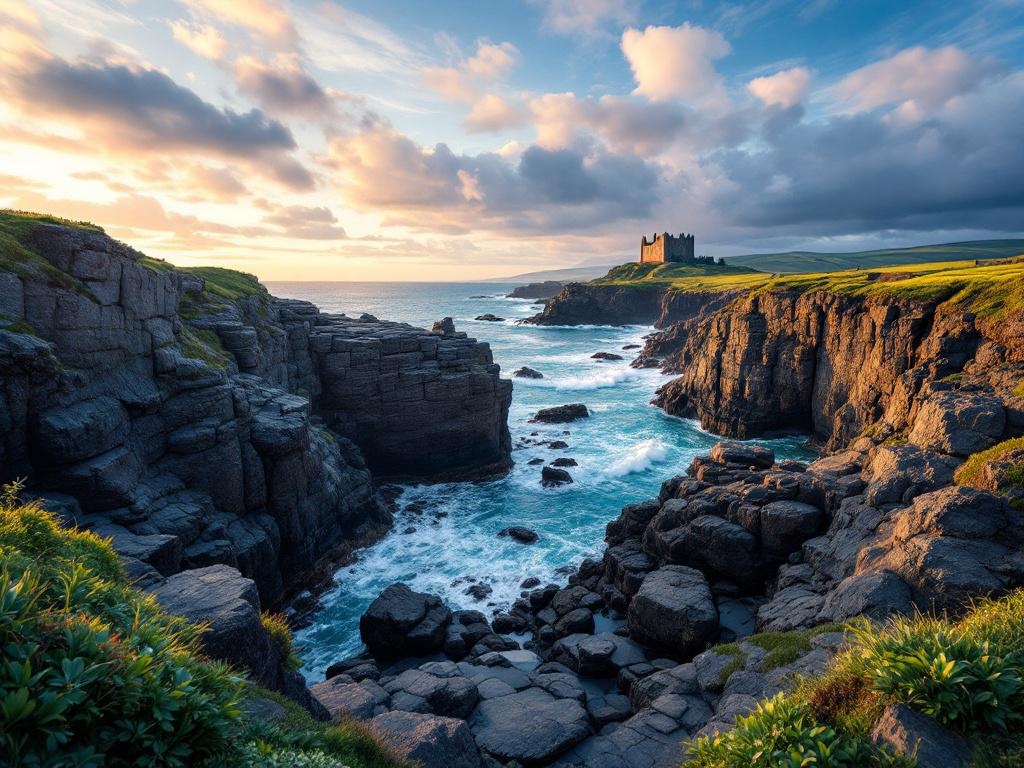Visiting the Giant’s Causeway in Northern Ireland
Journey to Northern Ireland’s Giant’s Causeway, a UNESCO World Heritage site boasting 40,000 basalt columns formed by volcanic activity 60 million years ago. Explore this geological marvel on the Causeway Coastal Route, steeped in Irish folklore. Discover convenient access, nearby attractions, and plan your visit with pre-booking tips. Uncover the legend of Finn McCool, capture stunning photos, and explore nearby Dunseverick Castle. Experience the Giant’s Causeway’s magic.
Important information

- The Giant’s Causeway is a UNESCO World Heritage site in Northern Ireland, famous for its roughly 40,000 interlocking basalt columns formed by volcanic activity around 60 million years ago.
- The site features a visitor center with exhibits, a storytelling team, and accessible facilities, including a Translink accessible bus.
- Visitors can explore the Causeway Coastal Route, nearby Dunseverick Castle, and Carrick-a-Rede Rope Bridge.
- The National Trust actively works to conserve the Giant’s Causeway’s natural beauty and diverse wildlife.
- Pre-booking tickets is recommended, especially during peak season, and visitors can utilize the park and ride system with shuttle buses.
Introduction to the Giant’s Causeway
Northern Ireland’s Giant’s Causeway is a popular attraction, drawing visitors from around the globe to its unique basalt columns. Located in County Antrim, this UNESCO World Heritage site is a geological marvel and a source of captivating Irish legends. Before you travel, make sure you have the necessary visa or permits. Check the latest entry requirements here with Passport Free Countries: https://passportfreecountries.org
What Makes the Giant’s Causeway a UNESCO World Heritage Site?
The Giant’s Causeway is renowned for its unique geological formations, a captivating display of interlocking basalt columns shaped by ancient volcanic activity. Designated a UNESCO World Heritage Site, this remarkable landscape is steeped in Irish folklore, including the legend of Finn McCool, adding a rich cultural dimension to its natural wonder.
Location and Accessibility in County Antrim
Explore the Giant’s Causeway, a geological wonder in Northern Ireland’s County Antrim, conveniently located on the Causeway Coastal Route. Access is easy by car, bus, or bicycle. Situated near the towns of Bushmills and Portrush, the Causeway also offers proximity to other attractions like Dunseverick Castle and the Carrick-a-Rede Rope Bridge.
Geological Marvel of the Giant’s Causeway
The Giant’s Causeway, composed of approximately 40,000 interlocking basalt columns, is a stunning result of volcanic activity about 60 million years ago.
Located on the Antrim coast, this extraordinary geological formation displays a remarkable collection of primarily hexagonal columns, with some pentagonal, heptagonal, and even octagonal shapes.
The columns’ diverse heights and diameters contribute to a visually striking landscape.
The causeway’s unique appearance is a consequence of rapidly cooling lava contracting during intense volcanic activity.
This site holds significant geological importance, serving as a prime example of volcanic processes and columnar jointing, a testament to the power of nature.
Formation of 40,000 Basalt Columns through Volcanic Activity
Millions of years ago, specifically between 50 and 60 million years ago, intense volcanic activity shaped the landscape. This activity created a massive lava plateau. As the cooling lava contracted, it fractured, forming distinctive, mostly hexagonal, columns. Some columns have four, five, seven, or even eight sides. This geological process is similar to the cracking of drying mud.
Unique Geological Features and Their Significance
The Giant’s Causeway is renowned for its predominantly six-sided basalt columns, formed by slowly cooling lava over 50 million years ago. This gradual contraction created a unique, stepped landscape resembling a natural amphitheater. The varying column sizes contribute to this dramatic effect. Scientists study these formations to better understand volcanic activity and geological processes. Beyond its geological significance, the Causeway supports a diverse ecosystem. The numerous columns provide small habitats sheltering various plants and animals, contributing to the site’s rich biodiversity.
Myths, Legends, and Cultural Significance
Irish folklore tells the tale of a giant named Finn McCool (or Fionn mac Cumhaill) who built a causeway to fight the Scottish giant Benandonner.
Irish Folklore: Stories of Finn McCool and Fionn mac Cumhaill
Legend says Ireland’s Giant’s Causeway was built by Finn McCool. He planned to battle a Scottish giant, Benandonner, but Benandonner was much larger. Finn’s wife cleverly disguised her husband as an infant. Upon seeing the giant “baby,” Benandonner was terrified, imagining the father’s immense size. He fled back to Scotland, ripping apart the causeway in his haste.
Planning Your Visit to the Giant’s Causeway
Planning your Giant’s Causeway adventure is easy with a few tips. Booking tickets in advance, especially during peak season, saves time and helps you avoid queues. Several transportation options are available, including the visitor center’s shuttle bus and park and ride services. Designated areas for campervans are also provided. For stunning photos, visit during sunrise or sunset for magical lighting and fewer crowds. The visitor center offers various amenities for your comfort.
Booking Tickets and Pre-booking Advice
Secure your Giant’s Causeway tickets in advance, especially during peak season, to guarantee entry and often save money. Pre-booking ensures a smooth and enjoyable visit.
Transportation: Shuttle Bus, Park and Ride, and Campervan Options
Travel to the Giant’s Causeway with ease using Translink’s shuttle service, operating directly from the visitor center. This park and ride system offers convenient parking, enabling you to leave your car and take a direct shuttle to the Causeway. Designated parking is available for cars, and dedicated spaces are also provided for campervans.
Best Times to Visit: Sunrise and Sunset Recommendations
Witness the magic of sunrise and sunset painting the basalt columns with vibrant colors. These less crowded times offer a more peaceful visit. Mornings provide soft, gentle light, while evenings bring warm, rich hues. For the best experience, visit during the pleasant weather of spring or early autumn. Aim for sunrise or sunset for a less crowded view of the magnificent basalt columns.
Visitor Experience at the Giant’s Causeway
Visit the Giant’s Causeway and witness breathtaking views of the Atlantic and Northern Ireland’s dramatic coastline. Enhance your experience with a scenic drive along the easily accessible Causeway Coastal Route. Deepen your understanding of the area’s geology and captivating legends through guided tours and audio guides. The Visitor Centre offers enriching exhibits, restrooms, and a dedicated storytelling team to bring the Causeway to life. Accessible to all, the center provides a Translink accessible bus and specialized equipment.
Stunning Atlantic Ocean Views and Coastal Scenery
The Giant’s Causeway unveils breathtaking vistas of the Atlantic Ocean. Its dramatic, rugged coastline enhances the basalt columns’ encounter with crashing waves. This picturesque scene provides visitors with countless photo opportunities, showcasing the location’s unique geological formations.
Exploring the Causeway Coastal Route
Embark on a memorable journey along the scenic Causeway Coastal Route, where you’ll encounter breathtaking coastal landscapes, the iconic Giant’s Causeway, and the historic Dunseverick Castle. Explore the area’s many walking trails, capturing stunning photographs along the way. Informative guided tours are also available, offering something for every interest. Discover unique rock formations and observe diverse wildlife, including oystercatchers, skylarks, and gannets, against the backdrop of the stunning Atlantic Ocean. This is a true nature lover’s paradise. Begin your adventure at the Visitor Centre, where educational exhibits reveal the area’s fascinating geology and mythology, plus helpful information about the surrounding region.
Guided Tours and Audio Guides
Explore the Giant’s Causeway with a guided tour led by experts who will share its history, geological marvels, and captivating legends. Or, embark on a self-guided adventure with audio guides that offer detailed insights into the columns’ formation, fascinating folklore, and cultural significance.
Visitor Centre: Facilities and Storytelling Team
The Giant’s Causeway Visitor Centre offers everything you need for a pleasant visit, including restrooms and a café. Explore fascinating exhibits detailing the site’s unique geology and history. The storytelling team brings the legend of Finn McCool to life, explaining the basalt columns’ formation. Easy-to-navigate walking paths and accessible viewing areas ensure a breathtaking and unforgettable experience for everyone.
Accessibility: Translink Accessible Bus and Equipment
Translink’s accessible bus routes simplify travel to the Giant’s Causeway, making the site more inclusive. The Visitor Centre also offers equipment to further enhance accessibility, allowing visitors with disabilities to more easily explore and enjoy this natural wonder.
Activities and Attractions Around the Giant’s Causeway
Embark on an unforgettable journey along the Causeway Coast Way, a 33-mile trail perfect for hikers and photographers alike. Capture breathtaking images of the unique rock formations and scenic views with readily available photography tips. Families, including dogs, are welcome, with dedicated areas for your furry companions.
Explore the historic ruins of Dunseverick Castle, a medieval fortress dramatically situated on a cliff edge.
For whiskey enthusiasts, a visit to the world-famous Bushmills Distillery is a must.
Thrill-seekers can challenge themselves on the exhilarating Carrick-a-Rede Rope Bridge.
Throughout your journey, marvel at the stunning coastal vistas of dramatic cliffs and crashing waves.
Walking Trails and Outdoor Activities
Explore the Giant’s Causeway with a range of walking trails for all skill levels. Enjoy breathtaking coastal views and the unique basalt columns from the cliff-top paths, or venture down to the intertidal zone for a closer inspection of these intriguing rock formations. Birdwatchers can also delight in spotting a variety of bird species, including oystercatchers, skylarks, and gannets.
Photography Tips for Capturing Rock Formations
Use a wide-angle lens from a low angle to emphasize the towering height of the basalt columns.
Capture a sweeping panoramic perspective from a higher vantage point.
Compose your shots using the rule of thirds for balanced images.
Use a telephoto lens to reveal the intricate textures and details within the rocks.
Take advantage of the golden hours of sunrise and sunset for soft, dramatic lighting.
Include the surrounding landscape and ocean to showcase the area’s complete beauty.
Use a polarizing filter to enrich colors and minimize glare.
Family-Friendly and Dog-Friendly Options
Embark on a family adventure at the Giant’s Causeway. Children will be fascinated by the unique basalt columns, discovering the area’s geology and captivating legends. Families with dogs are welcome, but please keep them leashed. The visitor center offers baby-changing facilities, and nearby cafes and restaurants provide family-friendly dining options. It’s the perfect day out for all ages.
Nearby Attractions: Dunseverick Castle and More
Explore Northern Ireland’s captivating coast, starting with the medieval ruins of Dunseverick Castle, near the Giant’s Causeway. For thrill-seekers, the Carrick-a-Rede Rope Bridge offers an exhilarating experience. History enthusiasts can delve into the intriguing Dunluce Castle. Embrace the scenic beauty of the Giant’s Causeway Coastal Route with a refreshing hike, and discover the charm of Ballintoy village.
Conservation and Wildlife at the Giant’s Causeway
Preserving the Giant’s Causeway’s unique basalt columns and surrounding environment is crucial. The National Trust actively works to minimize human impact, protecting the area’s natural beauty and diverse coastal habitat. Birdwatchers can spot various species, including oystercatchers, skylarks, and gannets. The Causeway’s remarkable rock formations are a must-see, but conservation efforts, like those of the National Trust, are essential to ensure future generations can also appreciate this natural wonder.
Conservation Work and Environmental Efforts
The National Trust protects the Giant’s Causeway, preserving its unique geology and diverse wildlife. Their work includes habitat restoration, path maintenance, and invasive species control. All of these efforts are guided by the Giant’s Causeway and Causeway Coast World Heritage Site Management Plan. This plan ensures sustainable tourism and preserves the site for future generations. Ongoing research monitors the impacts of climate change and visitor activity on the delicate ecosystem. Educational programs promote responsible behavior and highlight the importance of conservation. Accessible trails and facilities balance visitor access with environmental protection, a balance the National Trust carefully maintains.
Wildlife and Birdwatching: Oystercatchers, Skylarks, and Gannets
The Giant’s Causeway provides a haven for diverse bird species. Observe oystercatchers, distinguished by their black and white feathers and bright orange beaks, searching for food along the shore. Listen to the melodic songs of skylarks overhead. You might also spot gannets, with their wide wingspans, diving into the ocean.














